Irrational Number Line Games, LLC
home stuff-to-buy idea archive about-us contact
Dia de los Muertos/Tower Defense
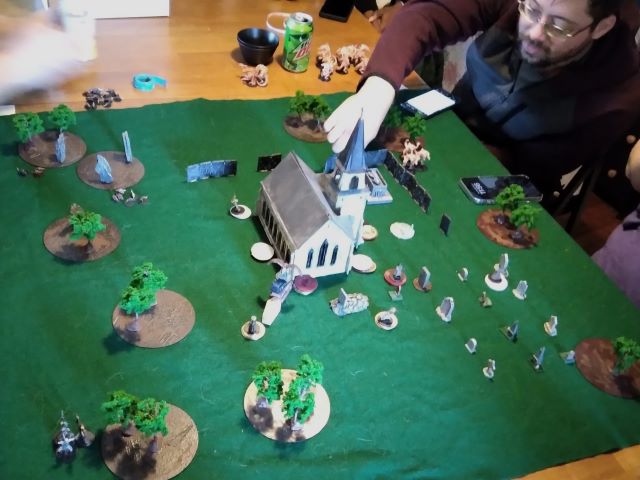 Bottom Line Up Front:
Bottom Line Up Front:
You and a few family members/friends/complete strangers are defending
the Dia de los Muertos offerings you have left for your ancestors from
a horde of the Bad Things that also sneak through the veil around this
time of year.
This is a tower defense type game where the players will be pitted
against relentless, savage automata. Lots of fun for 3-6 players,
and this version fits the seaonal theme well, too.
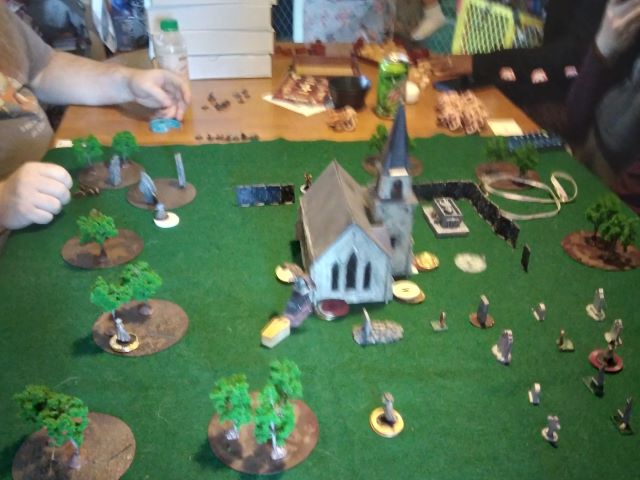 To start, you will need a church, the location the offerings to your
ancestors. Ours is 6"x3" for a 36"x36" board. This is predicated on
6" run move (no attack) for the monsters and 10" run move for the
heroes. With different games, the key is the monsters should take
four turns to reach the church and the heroes should be able to go about
half way around it in one turn.
To start, you will need a church, the location the offerings to your
ancestors. Ours is 6"x3" for a 36"x36" board. This is predicated on
6" run move (no attack) for the monsters and 10" run move for the
heroes. With different games, the key is the monsters should take
four turns to reach the church and the heroes should be able to go about
half way around it in one turn.
You also need some offerings. We used a stack of gold coins, but more
themed stuff would be better if you have it. Little sugar skulls would
be great, if you can not eat them during the game. For 4-6 players,
each player gets a stack of five. For 3 players, each gets two stacks
of three.
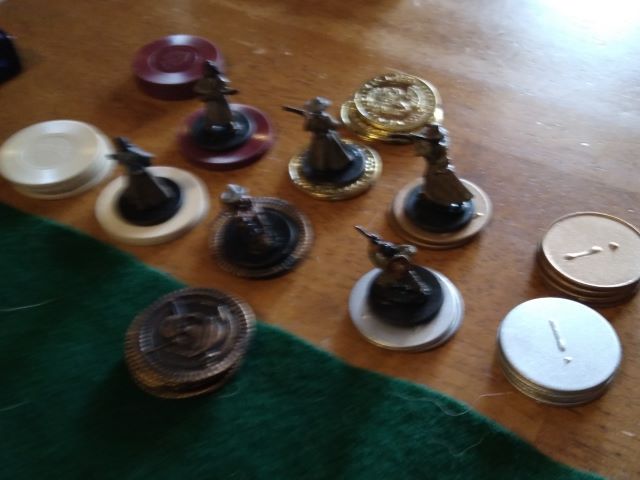 You will also need some armed (preferably) civilians. I am using the
citizens of Puebla from my Battle of Puebla set. The big thing is the
heroes can shoot and the monsters can't. So the heroes should be carrying
guns. If you use a "point system" or something like that, each hero
should be "worth" 8-10 monsters. For QILS we use a 3 die shooter and
a 1 die monster.
You will also need some armed (preferably) civilians. I am using the
citizens of Puebla from my Battle of Puebla set. The big thing is the
heroes can shoot and the monsters can't. So the heroes should be carrying
guns. If you use a "point system" or something like that, each hero
should be "worth" 8-10 monsters. For QILS we use a 3 die shooter and
a 1 die monster.
Color text: You are there with guns because: (1) you live in a horrible
urban area and always have a gun, (2) you live in a rural area where you
really need a gun to be safe from predators, (3) your abuela had a
psychic premonition about the Bad Things stealing the offerings, so you
thought it would be a good idea to grab a gun and intervene, or (4) you
don't need a logical set up for a tower defense game.
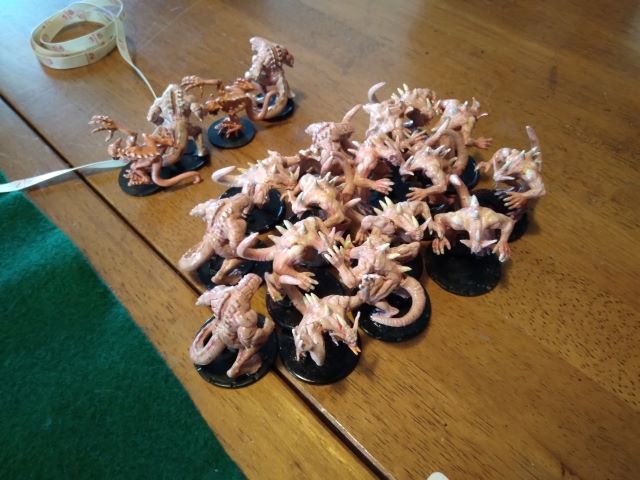 You will need four sets of 20 or so monsters. Each set gets assigned
to one of the suits from a deck of cards. Place each set in a corner
off the board, and put the ace of its suit there to remind you which is
which. You will want the four sets of monsters to be visually distinct,
so you can remember which is which on the board when they mix it up
a bit.
You will need four sets of 20 or so monsters. Each set gets assigned
to one of the suits from a deck of cards. Place each set in a corner
off the board, and put the ace of its suit there to remind you which is
which. You will want the four sets of monsters to be visually distinct,
so you can remember which is which on the board when they mix it up
a bit.
Instead of twenty 1-die ghouls, we have twelve and two 2-die ghouls
which are equivalent of roughly 4 1-die ghouls. When the big ghoul
gets shot, instead of dying, it is replaced with one of the 1-die ghouls.
A little variation.
 You have the monsters in the corners. To start place the heroes
and offerings in
positions next to the church. Pull the 10's, 9's, and 8's from the
deck and shuffle them.
You have the monsters in the corners. To start place the heroes
and offerings in
positions next to the church. Pull the 10's, 9's, and 8's from the
deck and shuffle them.
The game starts with a monster turn.
* Draw a card. If you're out of cards, reshuffle.
* Move the monsters of the drawn suit toward the nearest player or
pile of offerings, whichever is closer.
* If a monster can attack a person, it will.
* If a monster is adjacent to an offering pile, remove one offering and
then remove the monster from the board. It does not go back to the corner
to come out again. It just vanishes back to wherever.
* If there are monsters of that suit left off the board, put monsters
equal to the number on the card on the board as far in the corner as
possible. Note, there are no numbers on the face cards or jokers, so
monsters would move, but none would come out.
* When you're out of monsters at the corners, just move and don't add more.
* When you're out of monsters total (all killed or vanished), the game
is over.
* If you feel compelled to have a score, the player with the most
offerings left wins. For a tie, the player that killed the monst monsters
wins (so keep kills somewhere that you can tell that).
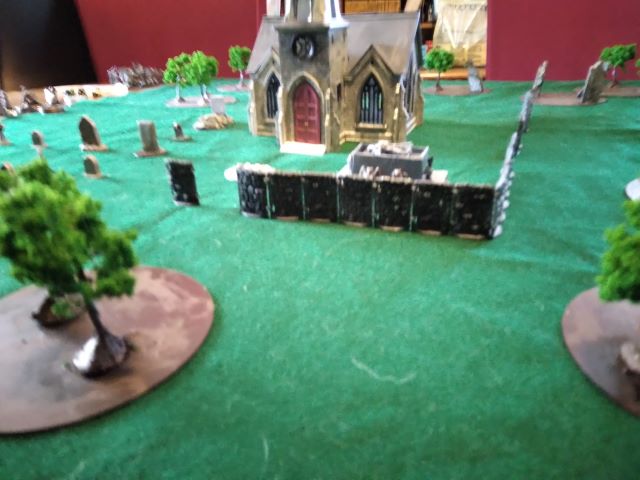 Good terrain might block monster movement. In that case, since this
isn't a crappy 80's video game where you can lure monsters into a corner
and they just get stuck there until you shoot them, it just walks
around the obstacle. Or climbs over, goes through, whatever is faster.
Good terrain might block monster movement. In that case, since this
isn't a crappy 80's video game where you can lure monsters into a corner
and they just get stuck there until you shoot them, it just walks
around the obstacle. Or climbs over, goes through, whatever is faster.
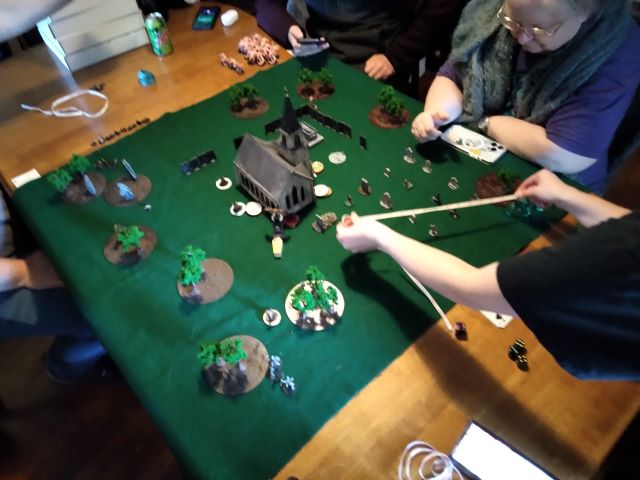 I recommend 25-33% terrain coverage for the board. This seems to be
enough to force monsters to do more than a bee-line for the church
and also limits too much long range sniping (the players will have to move out from the church to take out large groups before they arrive).
I recommend 25-33% terrain coverage for the board. This seems to be
enough to force monsters to do more than a bee-line for the church
and also limits too much long range sniping (the players will have to move out from the church to take out large groups before they arrive).
The game is built for maximum of three shots per hero, with an average
33% probability of kill per shot (more close in, less further out). If
you have more carnage capable heroes, you might want to tone them down
(best), or up the number of monsters (still works).
You can make the game harder by increasing the number of monsters (the
card deck works up to 54 per set if you add the 8, 9, and 10 back in),
or using tougher monsters. You can also
add the 8, 9, or 10 back into the deck for bigger clumps of monsters.
Rain is a nice theme-appropriate addition, especially if you want to
add penalties to ranged shots. Since the jokers have no numbers or
suits, they're like a "free turn" for the players. Unless its raining,
they then are a lightning flash that paralyzes the players - execute
two more monster turns before the players go again. Muahahahahaha!
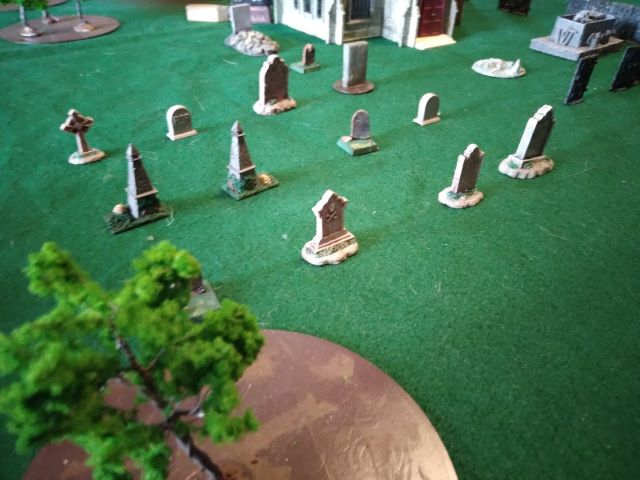 Mandatory graveyard shot for Halloween.
Mandatory graveyard shot for Halloween.
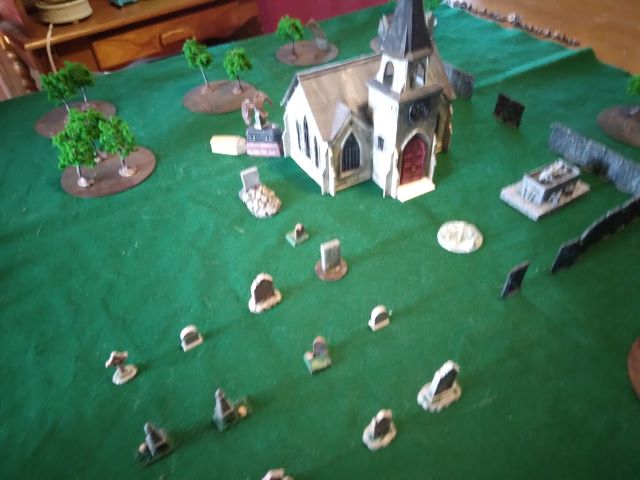 We originally (years ago) played this as a Dia de los Muertos game.
But it works well for a lot of tower-defense type scenarios.
We originally (years ago) played this as a Dia de los Muertos game.
But it works well for a lot of tower-defense type scenarios.
Swap the church with a postapocalytpic shelter. Instead of offerings,
you have critical supplies like plants and livestock that don't do
well inside. Or water and power junction boxes that could be inside
if you just got around to building more defenses during the copious
spare time that postapocalyptic survival gives you.
The same works as a "survive the night" with nocturnal monsters from
many genres. Protect the ship from too much damage to vital systems
that seem to be attracting the local fauna. They get zapped and die
when they bite into it, but the electromagnetic interference must
really be giving them a headache.
Because the monsters can come out in big packs and ones from one
direction can swing to another, players will have to collaborate or
they will end up getting swarmed. That said, I am here to protect
the offerings to my ancestors. A little collaborative-competitive.